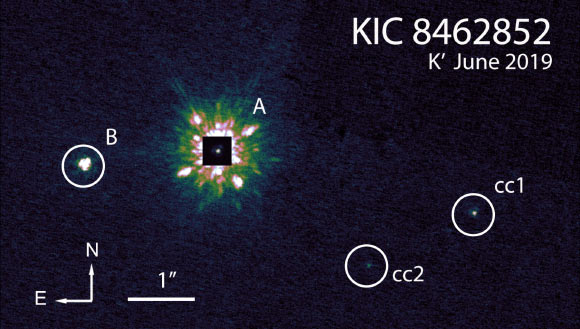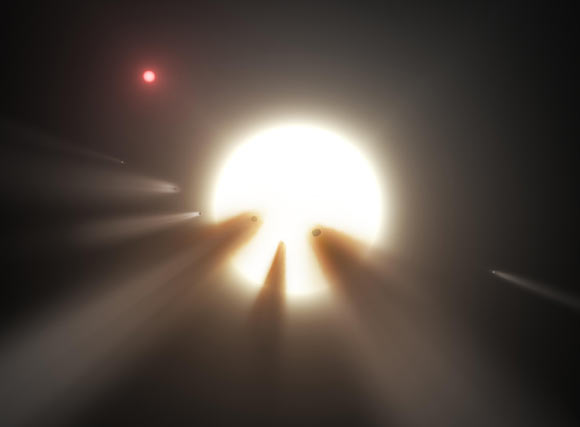KIC 8462852, a mysteriously dimming star located about 1,480 light-years away in the constellation of Cygnus, is, in fact, a binary stellar system, made up of a main-sequence F-type star and a smaller red dwarf star.

Keck/NIRC2 adaptive optics image of KIC 8462852A, KIC 8462852B, and candidate companions (cc1 and cc2). Image credit: Pearce et al., arXiv: 2101.06313.
KIC 8462852, also known as Boyajian’s star or Tabby’s star, exhibits large, aperiodic dips in a variety of shapes, inconsistent with an exoplanet explanation.
There has been significant interest in this star, with many suggested explanations from interstellar clouds, to a swarm of exocomets orbiting the star, to circumstellar dust, to debris from a melting exomoon, to alien megastructures.
“The light curve of KIC 8462852, a.k.a Boyajian’s star, undergoes deep dips the origin of which remains unclear,” Steward Observatory astronomer Logan Pearce and his colleagues from the United States and the United Kingdom wrote in their paper.
“A faint star 1.95’’ to the east was discovered in images from the Near Infrared Camera 2 (NIRC2) instrument on the Keck II telescope in 2015, but its status as a binary, and possible contribution to the observed variability, was unclear.”
In their work, the astronomers analyzed a series of Keck/NIRC2 images captured in 2014 (28 images), 2016 (13 images), and 2019 (10 images).
They found that the main star, KIC 8462852A, and its companion of spectral type M2V, KIC 8462852B, are a common proper motion pair and a gravitationally bound binary system.
“Since KIC 8462852B is a bound companion, we assume that it follows a Keplerian orbit around the center of mass of the system,” they wrote.
“An object on a circular, face-on orbit at the current 880 AU separation and a total system mass of 1.9 solar masses would have a velocity of 1.4 km/s and a period of 18,600 years.”
The astronomers think that it is unlikely that KIC 8462852B directly influences the light curve of the main star.
“Although it has not been thought to be a likely explanation for KIC 8462852A’s light curve, it is a potential source of instability in the long-term evolution of the system, and could excite chaotic orbits of objects in the system,” they wrote in the paper.
“Efforts to explain KIC 8462852A’s dimming events should be informed by the existence of a wide stellar binary companion to the system.”
The team’s paper will be published in the Astrophysical Journal.
_____
Logan A. Pearce et al. 2021. Boyajian’s Star B: The co-moving stellar companion to KIC 8462852. ApJ, in press; arXiv: 2101.06313








